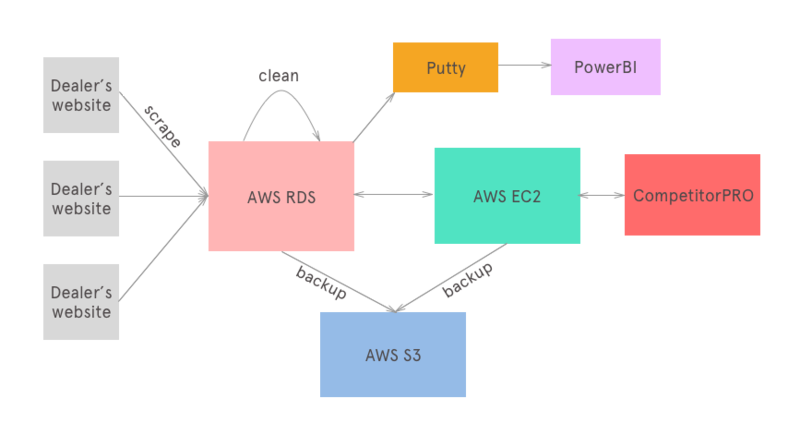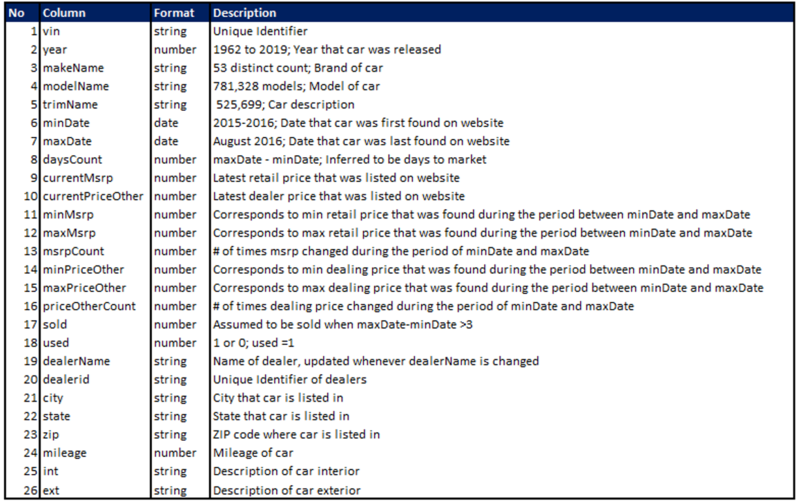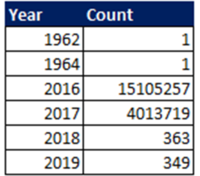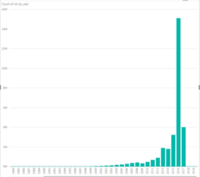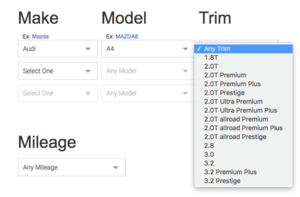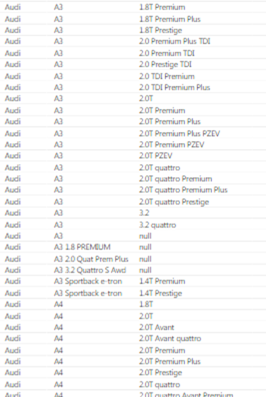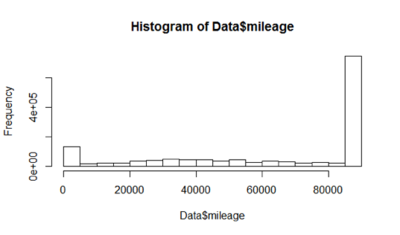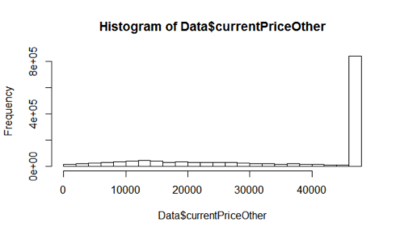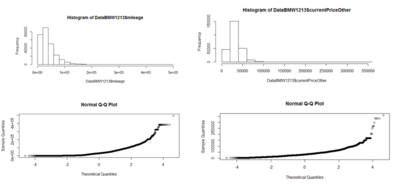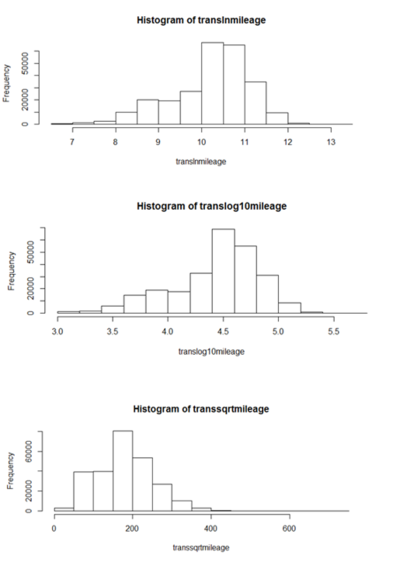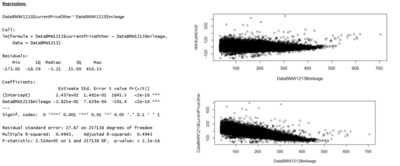Difference between revisions of "ANLY482 AY2016-17 T2 Group20 Project Overview"
| Line 156: | Line 156: | ||
Our hypothesis states that depreciation of cars is significantly different in each year, for different models and cities. | Our hypothesis states that depreciation of cars is significantly different in each year, for different models and cities. | ||
| − | H{0}: | + | H{0}: Only mileage, model and make affects depreciation of cars |
| − | H{1}: There are | + | H{1}: There are other factors that affect depreciation of cars |
We will also examine the effects of interaction of two or more factors on price. We will be implementing regression trees, using k-fold cross-validation to pick the complexity of the tree. Following that, we will be using randomForest modelling that automates the selection of the regression to predict the price range for any random used car. <br /> | We will also examine the effects of interaction of two or more factors on price. We will be implementing regression trees, using k-fold cross-validation to pick the complexity of the tree. Following that, we will be using randomForest modelling that automates the selection of the regression to predict the price range for any random used car. <br /> | ||
| Line 188: | Line 188: | ||
<u> Adjusted R^2 as a benchmark for selection of regression trees </u><br /> | <u> Adjusted R^2 as a benchmark for selection of regression trees </u><br /> | ||
| − | Adjusted R^2 can be very high as there is so much natural variation in car data. Hence switching to root-mean-square error (RMSE) for price (in USD dollars) could be a better alternative. In dollar terms, an error of $6,268 on the regression without city factor for the BMW training set. <br /> | + | Adjusted R^2 can be very high as there is so much natural variation in car data. It can be a case where too many terms are included and the regression model fits in random noise. Adjusted R^2 does not always catch this. Hence switching to root-mean-square error (RMSE) for price (in USD dollars) could be a better alternative. In dollar terms, an error of $6,268 on the regression without city factor for the BMW training set. <br /> |
<u> Too many levels in categorical factor </u><br /> | <u> Too many levels in categorical factor </u><br /> | ||
| − | For the BMW test set, there are 128 unique modelNames. There are very rare model names in the dataset which will influence regression results. After removing about 0.1% of the data for having very rare model names, which cut the sample to 28 models in the other 99.9%. 28 levels is still too high and taking a straight mean by model over production year from train and applying it to test produced an error of $5,666 on the test set. <br /> | + | For the BMW test set, there are 128 unique modelNames. There are very rare model names in the dataset which will influence regression results. After removing about 0.1% of the data for having very rare model names, which cut the sample to 28 models in the other 99.9%. 28 levels is still too high and taking a straight mean by model over production year from train and applying it to test produced an error of $5,666 on the test set. With a lower RMSE value, it indicates better fit and the standard deviation of unexplained variance is also lower. <br /> |
Hence, for further and future analysis, we may consider reducing number of levels for various makes. A possible way would be using the common models and re-categorising rare models as “Other”. However, this poses a conflict of interest with our client as the aim of the tool is to produce a price suggestion for each vin in the the United States. <br /> | Hence, for further and future analysis, we may consider reducing number of levels for various makes. A possible way would be using the common models and re-categorising rare models as “Other”. However, this poses a conflict of interest with our client as the aim of the tool is to produce a price suggestion for each vin in the the United States. <br /> | ||
Revision as of 21:47, 12 February 2017
Contents
Motivation and Business Problem
Background Information
On average, car dealers spend between $4000 and $20,000 on SaaS products. vAuto charges more as they are a one stop platform that provides inventory management and pricing advice. Other less established products as as VinSolutions, First Look and AAX commands much lesser for providing similar functions as vAuto does. In addition, many dealerships spend thousands to find out more about their main competitors. The used cars industry itself is highly competitive dominated by franchise dealers such as Legacy and Jim Ellis, followed by smaller individual dealers.
Business Problem
The car resale market makes up about 80% of the total automobile market in U.S.1. As of 2015, the car resale market is worth $111 bn2. As of now, most dealers do not have a systemised approach to pricing cars. Franchise dealers may purchase SaaS products such as vAuto, VinSolutions for pricing advice. Those that do not have these SaaS products may turn to pricing guides that are found online such as Edmunds.com True Market Value or Kelly Blue Book. However, some of these tools lack real time updates and short reaction time is crucial for dealerships as competitors update their listings as often as once per day.
The main problem we are addressing is that resale dealers do not know the best way to price their used cars. Even though other dealers’ pricing information can be found online, it is difficult for retailers to compare prices, mileage, make, customization along with other factors to come up with the most competitive price. Since the market is highly competitive, this problem is one worth solving. We think that by using current data on sales of used cars, modeling it can help our client help these resale dealers make better and faster decisions in setting competitive pricing.
Project Objectives
Deliverable
Analysis of historical sales data from dealers to create a model that will help our client help used car dealers price their cars competitively.
Functionality
We model the best suggested price range for the dealer to resell the used cars. These factors may include the car model, mileage, make of car, year of purchase, state, city and ZIP input. The factors will be refined further using feature engineering.
Output / Results
- Suggested optimal price range for car resale value
- Improved accuracy of prediction of price based on car model, mileage, make of car, year of purchase, state, city, ZIP input, etc.
- Pricing tool with geolocation of competitors
- Visualization of the data in an understandable manner for dealerships to make decisions regarding pricing
Project Details
CompetitorPRO's Architecture
The purpose of this diagram is to help us understand the product better and is not part of our solution.
Our model will be implemented in Competitor PRO.
- Data is collected using Ruby workers by crawling and scraping dealers’ websites each day. Information scrapped can be found in the 'Data Provided' section.
- All the collected raw data is stored in AWS RDS in a MySQL database.
- After collection of data, it is cleaned and the output is stored in another table in AWS RDS.
- The main application uses EC2 instances to access data from the AWS RDS MySQL database.
- PowerBI generates charts everyday and is used to ensure data crawl consistency and raise any failures of the application.
- AWS S3 is used as a storage backup for all data in the servers and databases.
Data Provided
Data is obtained through crawling of individual dealership websites and other service providers such as autotrader.com and edmunds.com. About 30,000,000 rows, approximately 6GB of data is obtained each day and appended to the database. Data collected is from multiple geographical territories.
The data is saved on MySQL Database and stored on S3 on Amazon Web Services as a .csv file. Below are the description of the 24 factors in the data provided.
This list is not final and might be changed during the course of the project.
Methodology
Data Exploration and Cleaning
Exploratory Data Analysis techniques were used to do a preliminary data sanity check. Using R, statistical description function were utilised to find number of missing values; min; max; range; sum of all non-missing values; median; average; standard error; variance and variance coefficient.
There were quite a few anomalies that need to be further explored.
1. Vin
Vin are unique identifiers of each car in the United States. National Highway Traffic and Safety Administration requires every car to have a Vehicle Identification Number (VIN), which contains information such as manufacturer information, manufacturer plant identification and associated data. There were at least 30,000 of vin duplicates found. Each vin was found to have up to 28 duplicates. These vin duplicates may have resulted from multiple resales but mostly, it comes from various websites where the same car can be listed on the individual dealer websites and other trading websites such as autotrader.com.
Each of these vin duplicate may have a different price listed with the same Year, Make, Model, Trim listed. However, a defining difference is where the timestamp where the data is crawled. From the maximum date, the latest updated data on each vin can be obtained.
2. Year
The min and max of year values found were 1962-2019. The variable “year” which identifies the year that the car was released was beyond 2016 and 2017. The client clarified and ensured that the reason for the data was that some car dealers may choose to not include the year the car was made, or to update the website with future releases of car models. Hence when we clean the data, we choose to remove outliers of data from year 2018-2019 as these models do not have currentPriceOther data.
3. makeName
Below shows the top 5 makes across categories.
4. trimName
Current trimNames are not clearly binned and there are too many levels in a factor. This poses a difficulty in terms of analysing trimNames as a factor for price. A recommendation was made to the developer team to create a dictionary for the trimName, as shown in the image below taken from Autodealer.com.
5. daysCount
daysCount refers to the days to market metric, the time taken for the car to be sold from when it is listed. The average days to market is found to be 42. The longest days to market for used cars was found to be 127.
However, we find that using daysCount as a benchmark can be inaccurate and lacks fair comparison. CompetitorPro can improve by grouping dealerships into various categories, such as large, medium and small by the number of cars in the lot or they could group dealerships by franchise and individual. This can improve the benchmarking system as dealers can compare within their own band of similar companies.
Others
In handling missing values, we chose to analyse only the available data and ignore the missing data. We consulted the developers who were in charge of crawling data and asked for the missing data. Data was assumed to be missing at random.
Histograms were also used to check for outliers. Below shows the histograms of currentPriceOther and mileage. Histograms were found to be skewed with 80% of values of a certain number for variables of price and mileage.
Upon investigation with the software developers, we found that the delimiter that they have used is in the form of a “,” which may have confused the crawlers as numbers can also contain a comma in the figure. And we suggested to change the “,” to a pipe or tab delimiter and that solved the issue.
Lastly, and the most important step, is to ensure that the crawlers are grabbing an accurate dataset. Checks on a random list of 300 individual vins on each website where the data was grabbed was done manually to ensure that the data we had was accurate.
Through this exercise, we found that there were links which are broken and websites where the data was not grabbed accurately. We informed our client regarding these websites and data was fixed.
We repeated the above steps once again with the same dataset obtained at different dates to do a data sanity check.
Through the exercise, we realised that the programmers do not put in enough interim checks to ensure that daily data is good. And hence we recommended them to put in certain checks such as visualisations to show the status of the application. We helped to link PowerBI with their mySQL data using Putty where it generates simple illustrations in the forms of graphs. For example, we used unique dealerCount to ensure that they have grabbed all data from all dealers in the United States.
These visualizations are automatically generated each day and early detection of system failure or errors is made possible.
Data Modelling
Factors considered
While the objective of the product is a pricing tool that is able to suggest a price range for a certain car in the market, this project started off as a data science project where we were testing various hypotheses regarding relationship of factors affecting price.
“Nothing is particularly hard if you divide it into small jobs” - Henry Ford, founder of the Ford Motor Company.
In a similar fashion, we chose to select factors that affects pricing most after consulting with industry experts. In choosing the most suitable variables, we considered various modelling techniques such as variable selection, variable clustering, decision trees, LARS and feature engineering.
There are many factors affecting depreciation of cars, including mileage, year that the car was released, city, make, model. Upon our conversation with David Chisnell and Professor George Easton, we decided to zoom into mileage, make, city and year for our hypothesis testing.
Our hypothesis states that depreciation of cars is significantly different in each year, for different models and cities.
H{0}: Only mileage, model and make affects depreciation of cars H{1}: There are other factors that affect depreciation of cars
We will also examine the effects of interaction of two or more factors on price. We will be implementing regression trees, using k-fold cross-validation to pick the complexity of the tree. Following that, we will be using randomForest modelling that automates the selection of the regression to predict the price range for any random used car.
Current Progress
After the data checks are complete, we removed irrelevant data which are out of range from our analysis. An example of irrelevant data would be outliers such as vins that are tagged for the year 2018 and 2019.
Below shows the histogram of mileage and price of cars for BMW. We consulted our client regarding our initial findings and the CEO gave feedback that it was reflective of the current trends. In testing regression, we tested our assumption of normality of a parametric distribution.
Since the raw data does not fit into any parametric distribution. We explored various transformations include log10, ln, sqrt, cubert. Below shows an example of the histograms after transformation of raw data.
We selected SQRT as the transformation to use for regression as it fits normal distribution the closest. Using the Quantile-Quantile Plot, we examine that using the transformation SQRT, the data points fall the closest to the 'ideal' diagonal line. Using stat.desc in R, we can also tell that the values of skew and kurtosis were the closest to 0 as compared to other transformations.
Results of regressions improved gradually from a simple basic regression of Price ~ Mileage (adjusted R-square of 0.4) to Price~Mileage + ModelName (adjusted R-square of 0.7) and to Price~Mileage + ModelName + Year (adjusted R-square of 0.8).
Below shows a screenshot of regression results. Please find the full example in File:RegressionBMW.xlsx
Observations
Geographical Boundaries
When regression included City as a factor, it became too granular and have resulted in overfitting. Current industry leaders such as Manheim and Cox Automotive have only explored and categorised United States into 6 geographical factors. A possible consideration for regression would be not going into specific cities or state, but to use the Pareto Principle to select the top 20% of cities which accounts for 80% of the cars in United States. Another possible way would be to use the city as a proxy for the states.
Adjusted R^2 as a benchmark for selection of regression trees
Adjusted R^2 can be very high as there is so much natural variation in car data. It can be a case where too many terms are included and the regression model fits in random noise. Adjusted R^2 does not always catch this. Hence switching to root-mean-square error (RMSE) for price (in USD dollars) could be a better alternative. In dollar terms, an error of $6,268 on the regression without city factor for the BMW training set.
Too many levels in categorical factor
For the BMW test set, there are 128 unique modelNames. There are very rare model names in the dataset which will influence regression results. After removing about 0.1% of the data for having very rare model names, which cut the sample to 28 models in the other 99.9%. 28 levels is still too high and taking a straight mean by model over production year from train and applying it to test produced an error of $5,666 on the test set. With a lower RMSE value, it indicates better fit and the standard deviation of unexplained variance is also lower.
Hence, for further and future analysis, we may consider reducing number of levels for various makes. A possible way would be using the common models and re-categorising rare models as “Other”. However, this poses a conflict of interest with our client as the aim of the tool is to produce a price suggestion for each vin in the the United States.
Defining geographical boundaries
Current geographical boundaries are divided by states and its counties. However, there are 50 states and 3114 counties which results in too many categorical variables. There are 3 possible methods to defining geographical boundaries. Firstly,, we could use the current industry geographical segmentation such as Nielsen DMAs or Manheim’s regional markets.
Since the pricing tool is a competitive tool helping dealers to get a competitive edge against another dealer. Hence, another possible way of defining geographical boundaries is to use a customised version such as drawing a radius of 100 miles by ZIP centroid. While this approach is easy to understand and avoids concerns from dealerships who sit on boundaries of county or state lines, it is computationally intensive as we run a separate query and regression for every dealer in the United States.
Lastly, we could continue with geographical boundaries based on state and county lines or create our own geographical segmentation.
Application Visualization
This web application is catered for car dealers and salespeople from Automotive Ventures.
Input by user
Users will be required to fill in the following details: Mileage, Model, Make, Year, State, City and ZIP code.
Output
Our pricing model will include:
- Suggested optimal price range for car resale value
- Number of cars with the same Year, Make and Model
- Top 5 dealers based on competitive pricing
There will be several output provided by our web interface such as:
- Geolocation of competitors
- Trellis plot
Technology
| Technology | Function |
|---|---|
| HTML |
HTML5 for the front end of web application |
| CSS |
CSS3 for the front end of web application |
| JavaScript |
D3 library for visualization if needed. jQuery to simplify Javascript functions and ensure cross-browser functionality |
| MySQL |
Query database used for CompetitorPro application |
| AWS EC2 |
Cloud computing power for scalability. To repeat tests and run automated codes |
| Python |
Scikit for random forest (http://scikit-learn.org/stable/index.html) |
| Ruby |
Ruby on Rails for backend of web application |
| R | Statistical Analysis of Data, randomForest modelling, regression trees.
Shiny R - To build web applications based using R.
|
Risks & Limitations
| Risks & Limitations | Mitigation Strategy |
|---|---|
| Data received unusable for analysis |
Clear and effective communication with client and supervisors to manage expectations and ensure that data required is given within a week |
| Lack of experience with analytical modelling (eg. randomForest) |
Explore and familiarise with the analytical modelling prior to using them to perform actual analyses. Read previous projects done by community and consult advisors. |
| Changes in work schedule due to unexpected events, delays and time zone difference |
Communicate with client and set regular meeting timings. Team members to stay up to date on deliverables and project timeline.
|
References
1http://www.niada.com/uploads/dynamic_areas/tRRlH6fX2WoqiCcaonlq/33/2015ManheimUsedCarMarketReport.pdf 2https://www.ibisworld.com/industry/default.aspx?indid=1004
Unique identifiers of car, VIN :
- National Highway Traffic Safety Administration: https://vpic.nhtsa.dot.gov/decoder/
- What is in a VIN? https://vpic.nhtsa.dot.gov/

Research on randomForest modeling:
